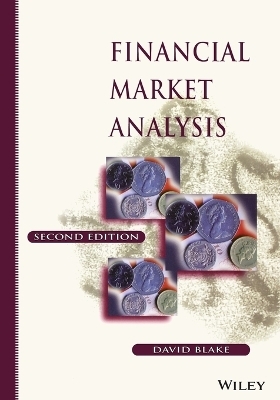
Financial Market Analysis
John Wiley & Sons Inc (Verlag)
978-0-471-87728-8 (ISBN)
The eagerly awaited second edition of this highly successful book has been greatly expanded from 400 to over 700 pages and contains new material on value at risk, speculative bubbles, volatility effects in financial markets, chaos and neural networks.
Financial Market Analysis deals with the composition of financial markets and the analysis and valuation of traded securities. It describes the use of securities both in constructing and managing portfolios and in contributing to portfolio performance. Particular attention is paid to new types of investment product, different portfolio management strategies, speculation, arbitrage and risk management strategies and to financial market failure.
Financial Market Analysis is an essential text for all finance-related degree courses at undergraduate, postgraduate, and MBA level. It also provides a useful source of reference for financial institutions and professionals in the financial markets.
DAVID BLAKE is Professor of Pension Economics and Director of the Pensions Institute at Cass Business School, London, and Chairman of Square Mile Consultants, a training and research consultancy. He was formerly Director of the Securities Industry Programme at City University Business School, Research Fellow at both the London Business School and the London School of Economics and Professor of Financial Economics at Birkbeck College, University of London. He is consultant to many organisations, including Merrill Lynch, Deutsche Bank, Union Bank of Switzerland, Paribas Capital Markets, McKinsey & Co., the Office of Fair Trading, the Office for National Statistics, the Government Actuary's Department, the National Audit Office, the Department for Work and Pensions, HM Treasury, the Bank of England, the Prime Minister's Policy Directorate and the World Bank. In June 1996, he established the Pensions Institute, which undertakes high-quality research on all pension-related issues and publishes details of its research activities on the internet.
Preface xix
Abbreviations xxi
I Introduction to Financial Markets 1
1 The Financial System 5
1.1 Participants 5
1.1.1 End-users of the financial system 5
1.1.2 General financial intermediaries 7
1.1.3 Specialist financial intermediaries 12
1.1.4 Market-makers 16
1.2 Securities 16
1.3 Markets 20
1.3.1 The classification of financial markets 20
1.3.2 Financial markets in the UK 25
1.4 Trading arrangements 38
1.4.1 Types of order 39
1.4.2 Types of account 39
1.4.3 Stock borrowing agreements 41
1.4.4 Clearing and settlement of trades 42
1.4.5 Official intervention in markets 43
1.5 Regulation 44
1.6 The financial system in a temporal context 51
1.6.1 The recent past: the Big Bang of October 1986 51
1.6.2 The near future 53
Appendix: The City Research Project 1991-95 69
2 The market determination of discount rates 79
2.1 The price of time and risk 79
2.2 The expected real interest rate 80
2.3 The expected inflation rate 82
2.4 The expected liquidity premium 83
2.5 The expected risk premium 84
2.6 Interest rates and discount rates 87
3 Financial arithmetic 89
3.1 Future values: single payments 89
3.1.1 Simple interest 89
3.1.2 Compound interest: annual compounding 90
3.1.3 Compound interest: more frequent compounding 90
3.1.4 Flat and effective rates of interest 92
3.2 Present values: single payments 92
3.2.1 Present value: annual discounting 92
3.2.2 Present values: more frequent discounting 93
3.3 Future values: multiple payments 93
3.3.1 Irregular payments 93
3.3.2 Regular payments: annual payments with annual compounding 94
3.3.3 Regular payments: annual payments with more frequent compounding 95
3.3.4 Regular payments: more frequent payments and compounding 96
3.4 Present values: multiple payments 96
3.4.1 Irregular payments 96
3.4.2 Regular payments: annual payments with annual discounting 97
3.4.3 Regular payments: annual payments with more frequent discounting 97
3.4.4 Regular payments: more frequent payments and discounting 98
3.4.5 Perpetuities 100
3.5 Rates of return 100
3.5.1 Single-period rale of return 100
3.5.2 Internal rate of return or money-weighted rate of return 101
3.5.3 Time-weighted rate of return or geometric mean rate of return 103
Appendix: A simple iterative method for calculating internal rates of return 104
II The Analysis and Valuation of Securities 107
4 Monty market securities 111
4.1 Securities quoted on a yield basis 112
4.1.1 Money market deposits 112
4.1.2 Negotiable certificates of deposit 113
4.2 Securities quoted on a discount basis 116
4.3 Recent innovations 120
5 Bonds 123
5.1 Types of bond 123
5.2 The fair pricing of bonds 127
5.3 Clean and dirty bond prices 128
5.4 Yield measures on bonds 129
5.4.1 Current yield 130
5-4.2 Simple yield to maturity 131
5.4.3 Yield to maturity 131
5.4.4 Holding-period yield 135
5.4.5 Yield to par 135
5.4.6 Yield to call and yield to put 135
5.4.7 Yield to average life and yield to equivalent life 136
5.4.8 Index-linked yields 138
5.5 Yield curves 141
5.5.1 The yield to maturity yield curve 142
5.5.2 The coupon yield curve 142
5.5.3 The par yield curve 142
5.5.4 The spot (or zero-coupon) yield curve 144
5.5.5 The forward yield curve 146
5.5.6 The annuity yield curve 150
5.5.7 Rolling yield curve 150
5.6 Theories of the yield curve 152
5.6.1 The expectations hypothesis 152
5.6.2 The liquidity preference theory 153
5.6.3 The segmentation or preferred habitat theory 154
5.7 Fitting the yield curve 154
5.7.1 Polynomial curve fitting 154
5.7.2 Regression analysis 155
5.7.3 Matrix modelling 156
5.8 Interest rate risk 158
5.8.1 Duration 158
5.8.2 Convexity 164
5.8.3 Dispersion 166
5.9 Floating rate notes 166
5.10 Recent innovations: the gilt repurchase market 170
6 Shares 181
6.1 Types of share in the firm 181
6.2 The financial structure of the firm 183
6.2.1 The income statement and statement of retained earnings 183
6.2.2 Inflation accounting 184
6.2.3 Depreciation 184
6.2.4 Corporation tax and corporate capital gains tax 185
6.2.5 The effect of accounting conventions on reported earnings 188
6.2.6 The balance sheet 190
6.3 The fair pricing of shares 192
6.3.1 Valuation based on expected dividends 192
6.3.2 Valuation based on expected earnings 194
6.4 Dividend policy 196
6.5 Earnings analysis 198
6.5.1 Constant or normal growth models 198
6.5.2 Differential growth models 201
6.5.3 Forecasting earnings 205
6.6 The value of the firm: the effect of leverage 206
7 Foreign currency 215
7.1 The foreign exchange market 215
7.1.1 Spot foreign exchange transactions 216
7.1.2 Forward foreign exchange transactions 219
7.2 Exchange rate risk 222
7.3 Covering foreign exchange transactions 226
7.3.1 Covering forward transactions 226
7.3.2 Covering spot transactions 228
7.4 The fair pricing of foreign currency 230
7.4.1 Consistent cross exchange rates 230
7.4.2 Purchasing power parity 231
7.4.3 International Fisher effect 234
7.4.4 Covered interest rate parity 235
7.4.5 Uncovered interest rale parity 236
8 Forwards and futures 239
8.1 Forward and futures contracts 239
8.1.1 Forward contracts 239
8.1.2 Futures contracts 240
8.2 Financial futures contracts 244
8.2.1 Short-term interest rale futures 247
8.2.2 Long-term interest rate futures 250
8.2.3 Currency futures 257
8.2.4 Stock index futures 257
8.3 The fair pricing of forward and financial futures contracts 260
8.3.1 Fair pricing with no uncertainty 260
8.3.2 Futures prices and expected spot prices 262
8.3.3 Fair pricing of the short-term interest rate contract 263
8.3.4 Fair pricing of the long-term interest rate contract 264
8.3.5 Fair pricing of the currency contract 266
8.3.6 Fair pricing of the stock index contract 267
9 Options, warrants and convertibles 273
9.1 Option contracts 273
9.2 Option combinations 277
9.3 Financial options contracts 283
9.3.1 Equity options 288
9.3.2 Interest-rate options 291
9.3.3 Currency options 297
9.3.4 Stock index options 297
9.3.5 Restricted-life traded options 301
9.3.6 Traditional options 302
9.3.7 Over-the-counter options 302
9.4 The fair pricing of options contracts 303
9.4.1 Factors influencing the premium 303
9.4.2 Boundary conditions for options 304
9.4.3 The binomial model of the fair European call option price 309
9.4.4 The Black-Scholes model of die fair European call option price 312
9.4.5 Properties of the Black-Scholes model: the Greeks 316
9.4.6 Pricing a European put option 321
9.4.7 Modifications to the Black-Scholes model 322
9.5 Exotic options 327
9.6 Warrants and convertibles 334
9.6.1 Warrants 334
9.6.2 Convertibles 336
Appendix A: Accounting issues with options and futures contracts 338
Appendix B: Taxation issues with options and futures contracts 340
Appendix C: Standard normal distribution table 342
10 Synthetic securities 349
10.1 The basic building blocks of synthetic securities 349
10.2 Synthetic options and futures 352
10.3 Swaps 357
10.3.1 Interest rate swaps 358
10.3.2 Basis swaps 363
10.3.3 Currency swaps 363
10.3.4 Asset swaps 369
10.3.5 More esoteric swaps 370
10.3.6 The risks involved in swaps 371
10.3.7 The uses of swaps 372
10.4 Forward rate agreements 373
10.5 Caps, floors and collars 375
10.6 Bundled and unbundled securities 378
10.6.1 Bundled securities 378
10.6.2 Unbundled securities 380
III Portfolio Analysis, Management and Performance Measurement 385
11 Market efficiency: theory and evidence 389
11.1 Allocative operational and informational efficiency 389
11.2 The EMH the fair game model and random walk 390
11.3 The EMH and information 392
11.4 The EMH and an information-efficient equilibrium 393
11.5 Tests of the efficient markets hypothesis 394
11.5.1 Evidence favouring the efficient markets hypothesis 394
11.5.2 Evidence against the efficient markets hypothesis 398
11.5.3 Are the financial markets efficient? 405
12 Speculation and arbitrage 415
12.1 Speculation 415
12.1.1 The process of speculation 415
12.1.2 Trading strategies with futures 417
12.1.3 Trading strategies with options 426
12.2 Arbitrage 434
12.2.1 The process of arbitrage 434
12.2.2 Arbitrage strategies with futures 435
12.2.3 Arbitrage strategies with options 439
Appendix A: The collapse of Barings Bank 441
Appendix B: Technical analysis 444
13 Portfolio analysis and asset pricing 461
13.1 Portfolio analysis 461
13.1.1 Choice under uncertainty: the consumption of risk and return 461
13.1.2 Portfolios under uncertainty: the production of risk and return 465
13.1.3 Diversification 468
13.1.4 The minimum standard deviation portfolio opportunity set and the efficient set 474
13.1.5 The efficient set when there is a riskless security 476
13.1.6 Market equilibrium, portfolio optimally and the pricing of efficient portfolios 477
13.1.7 Pricing inefficient portfolios and the decomposition of total risk 482
13.2 Asset pricing 489
13.2.1 The capital asset pricing model 489
13.2.2 The multi-factor model 501
13.2.3 The arbitrage pricing model 501
14 Portfolio management 511
14.1 The functions of portfolio management 511
14.2 Assessing the investing client’s utility function 514
14.3 Passive portfolio management 519
14.3.1 Passive portfolio management for an expected utility-maximizing client 519
14.3.2 Passive portfolio management for a safety-first client 521
14.4 Active portfolio management and adjustment 528
14.4.1 Active share portfolio management and adjustment 528
14.4.2 Active treasury portfolio management 537
14.4.3 Active bond portfolio management and adjustment 538
14.5 Mixed active-passive portfolio management 542
14.6 Investment management styles 544
14.6.1 Traditional investment management 545
14.6.2 Quantitative investment management 547
14.7 Recent innovations: hedge funds and bear funds 548
Appendix: Investment-Objectives Questionnaire 550
15 Portfolio performance measurement 559
15.1 The components of portfolio performance measurement 559
15.1.1 Ex post returns 559
15.1.2 Adjusting for risk 562
15.1.3 Benchmarks of comparison 562
15.2 Measures of portfolio performance 564
15.2.1 Performance measures based on risk-adjusted excess returns 564
15.2.2 Performance measures based on alpha values 567
15.3 The decomposition of total return 570
15.4 Treasury performance measurement 574
15.5 Asset-liability managed portfolios 574
15.6 Portfolios containing financial futures and options contracts 578
15.6.1 Individual treatment of futures 578
15.6.2 Individual treatment of options 579
15.6.3 A worked example 580
15.7 Performance measurement with multiple fund managers 586
15.8 The Roll critique of performance measurement 588
15.9 Evidence on the performance of fund managers 588
Appendix: A note on the different uses of the geometric mean and the arithmetic mean 590
16 Hedging and efficient portfolio management 597
16.1 The objective of hedging 597
16.2 Money market hedges 599
16.3 Hedging using futures 601
16.3.1 Hedging with short-term interest rate futures contracts 601
16.3.2 Hedging with stock index futures contracts 604
16.3.3 Hedging with long-term interest rate futures contracts 613
16.3.4 Hedging with currency futures contracts 617
16.4 Hedging using options 620
16.4.1 Hedging with individual stock options contracts 621
16.4.2 Hedging with stock index options contracts 627
16.4.3 Hedging with short-term interest rale options contracts 630
16.4.4 Hedging with long-term interest rate options contracts 631
16.4.5 Hedging with currency options contracts 632
16.5 Hedging with swaps and swaptions 633
16.6 Hedging with FRAs 637
16.7 Hedging with caps, floors and collars 637
16.8 Portfolio insurance 638
16.9 Efficient portfolio management 643
IV Postscript 655
17 The failure of financial markets 659
17.1 The anatomy of the crash 659
17.2 The consequences of the crash 661
17.3 The causes of the crash 663
17.4 Conclusion 669
18 Recent developments in financial market analysis 673
18.1 Value-at-risk analysis 673
18.2 Speculative bubbles 676
18.3 Volatility effects in financial markets 678
18.4 Chaos 682
18.5 Neural networks 693
| Erscheint lt. Verlag | 29.9.1999 |
|---|---|
| Verlagsort | New York |
| Sprache | englisch |
| Maße | 190 x 250 mm |
| Gewicht | 1276 g |
| Themenwelt | Schulbuch / Wörterbuch |
| Wirtschaft ► Betriebswirtschaft / Management | |
| Wirtschaft ► Volkswirtschaftslehre ► Finanzwissenschaft | |
| Wirtschaft ► Volkswirtschaftslehre ► Makroökonomie | |
| ISBN-10 | 0-471-87728-X / 047187728X |
| ISBN-13 | 978-0-471-87728-8 / 9780471877288 |
| Zustand | Neuware |
| Haben Sie eine Frage zum Produkt? |
aus dem Bereich


